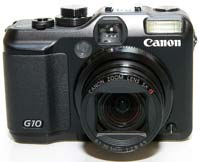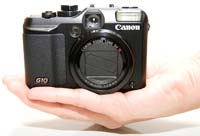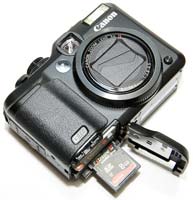Canon Powershot G10 Review
Review Date: October 27th 2008
Author: Mark Goldstein
Leave a comment about this review
|
Introduction

The Powershot G10 is the latest version of Canon's most capable, serious and expensive compact camera. The G10 has a wealth of features that will appeal to the DSLR owner looking for a backup compact, or the enthusiast who wants DSLR functionality without the added bulk. At first glance the Canon G10 looks very similar to its popular predecessor, the G9, but as with that model, there are a number of key external and internal changes underneath the serious matt black exterior. The seemingly endless megapixel race continues, with the G10 now offering a 14.7 megapixel sensor - up from the G9's 12.1 megapixels - which is coupled with Canon�s new DIGIC 4 image processor, promising faster operation and improved image quality. The LCD screen remains 3 inches in size, but the resolution has been doubled to 461k dots, and there's a new dedicated Exposure Compensation dial and dual ISO/shooting mode dial on top of the camera. Perhaps the most significant change is the new 5x, 28-140mm zoom lens, which provides less range and reach than the G9's 6x lens with its telephoto setting of 210mm, but offers a wider-angle of view (28mm versus 35mm on the G9). The new G10 retains the same RAW shooting mode, optical image stabilizer to help combat camera-shake, optical viewfinder, flash hotshoe, ISO range of 80-3200, and 26 different shooting modes including Shutter-priority, Aperture-priority and Manual shooting modes for those who desire greater control. 640x480 pixel movies at 30fps, a new i-Contrast system which increases the dynamic range, Servo AF mode to continually adjust focus on a moving subject, a My Colors mode that allows special in-camera colour effects, 1cm macro mode, and improved Face Detection system complete the headline specification.
Compare Prices
Support PhotographyBLOG: Buy the Canon Powershot G10 from one of our affiliate retailers:Ease of Use
Canon's G-series range of compact cameras have long been the preserve of the dedicated enthusiast photographer, stuffed so full of features that they're worthy of being described as a bridge camera, and just one step down from a fully fledged DSLR. The question is, why opt for the Canon Powershot G10, when for nearly the same price you could be the proud owner of an interchangeable lens EOS 1000D / Digital Rebel Xs DSLR? For starters, the G10, despite its rather boxy dimensions, slots handily into a coat pocket, therefore suggesting itself as possibly the most over-qualified spur-of-the-moment snapshot camera out there. Although there are add-on tele and wide conversion lenses available, the advantage that the G10 has over similar bridge cameras, super zooms and ultimately DSLRs is that its admittedly modest yet thankfully image stabilized 5x zoom (a still respectable 28-140mm range in 35mm terms) is stored flush to the body when not in use.
Just like its predecessors, the build quality is one of the G10's aspects that immediately impresses as soon as you handle it for the first time. It feels like it could be dropped, bashed around a bit (possibly shot at) and still come back for more, like some war photojournalist's trusty Leica. It certainly doesn't feel like Canon has cut any corners to bring the camera to market at this price (�449 RRP in the UK and $499 in the US, slightly more expensive in the UK than the previous G9 model), with its matt black finish denoting a serious intent. Although, as the lengthy spec list shows, Canon has crammed a plethora of photographic controls into the camera body, everything within the layout feels in its rightful place and is easily � and intuitively � accessible in an instant.
Two of the most visible changes to the G10 are found on front of the camera. There's a much-improved rubber handgrip, which is altogether more tactile and, well, grippy, than the one found on the previous G9 model. Alongside that is the new 5x zoom lens. Although it offers a shorter telephoto focal length compared to the G9 (140mm versus 200mm), I suspect that the majority of users will welcome Canon's decision to incorporate a wide-angle 28mm setting. Gaining 7mm at the wide-angle end makes a much bigger difference than losing 60mm at the telephoto end, making it much easier to shoot subjects like buildings in narrow streets, or a group of your friends in a confined space.
On top of the G10 and located to the far left (if the camera is viewed from the back), is a new, very useful dial for changing exposure compensation. This is a great addition which really encourages you to fine-tune and experiment with the exposure level, and is a much better system than those found on the 99% of other compact cameras. To accommodate this new control, the dedicated ISO dial for rapidly changing light sensitivity settings, from auto through to ISO 1600, has moved over to the right-hand side of the hot shoe for the supplementary flash. Canon have cleverly located the familiar shooting mode dial in the center of the ISO dial.
Starting at full auto setting, and moving clockwise around the dial are shooting options including pre-optimised scene modes (that feature a high speed ISO 3200-equivalent option), stitch assist for framing panoramic images, movie clip mode (an advantage over a DSLR for some users), and full Auto, followed by six 'creative zone' modes. These are the regulars of program, shutter speed priority (Tv), aperture priority (Av), manual, plus a choice of two readily accessible custom settings. The combination of exposure compensation, ISO and shooting mode dials is a winning one, providing quick access to the camera's principal controls. Located to the right of the ISO/shooting mode dials are a forward-situated zoom lever encircling a raised and very springy feeling shutter button, behind which sits a slightly recessed rectangular on/off button. It's to Canon's credit that despite all of these controls falling immediately at your fingertips, nothing feels cramped, compromised or unnecessarily miniaturized for the sake of 'fashion', which, to be frank, is a breath of fresh air for any compact camera user.
 |
 |
| Front | Rear |
The rear of the Powershot G10 is dominated by a large fixed 3-inch LCD screen, the same size as the screen on the older G8, but importantly doubling the resolution from 230k to 460k dots. There's a rounded window for the slightly bigger optical viewfinder ranged immediately above the LCD screen, but to be honest, I found myself using the G10's screen for shot composition in the main. This has a couple of advantages: firstly, you can see the live on-screen histogram to check exposure as you go, and secondly, a compositional nine-area grid provides added assistance when framing landscapes and attempting to get your horizon level. Screen visibility is also universally good, in contrast to the optical viewfinder which appeared murky when used indoors under artificial light. The 3 inch LCD screen has conversely resulted in a decrease in the size of the optical viewfinder, making it more difficult to use than on the older G7 model. Also off-putting is the fact that you can see the lens in the bottom-left of the viewfinder when it's set to a wide-angle focal length, and you can only see around 80% of the scene anyway.
Although the G10 can be operated with one hand, using both feels more comfortable, even though, with a lack of a grip to the left hand side of the body, it's easy to smear the side of the LCD with thumbprints. Top right of the LCD monitor is a self-explanatory playback button, with a customary Canon direct print button for PictBridge compliant printers top left that, if wanted, doubles up as a shortcut button. Immediately right of the LCD are four buttons ranged at compass points around a control dial that features a scroll wheel (for sifting through captured images and navigating menus) encircling a function set button. Most of the external buttons on the G10 are now raised, making them easier to access than on the G9, and the name of the principal function is directly printed on each one.
These buttons include one for deleting images that doubles up as a means of switching between AF options (face detection, AiAF � standard auto � plus FlexiZone AF), a second for adjusting the metering mode (evaluative, centre weighted and spot), a third for switching the display on or off (including the aforementioned nine-zone grid and histogram), while the fourth is a singular menu button for calling up just that on-screen. Finally for the camera back, top right of this is a button for adding voice annotations to images in playback that doubles up as an AE and FE (Flash Exposure) lock button. On the right flank of the camera � again if viewed from the back � is a sturdy pull-out flap protecting USB, remote cable and AV out ports, above which is a handy mount for a neck or wrist strap. On the left hand side is another strap mount, below which is a speaker.
A press of the 'Func / Set' button at the centre of the control dial brings up an L-shaped toolbar running up the left hand side and across the bottom of the screen. As with other Canon compacts, you scroll up and down this to select and affect various key functions on the fly. In Auto mode, most are disabled and all the user is allowed to do is change file size and quality � large and superfine being the best (least compression) option. Flick the shooting dial around to Program however and you get the added options of being able to adjust white balance � which includes both an underwater and custom setting � plus access the familiar, but often unused, 'My Colors' menu, bracketing options, flash strength, and, rather more interestingly, switch a neutral density (ND) filter on/off for those contrasty landscapes.
These myriad options remain for the other main shooting modes, with various features obviously subtracted when shooting video clips � although you still get white balance, My Colors, and use of the ND filter if required � which adds the options of being able to shoot at 320x240 pixels or 640x480 at 30fps or 15fps depending on end usage. Turning the mode dial again to access the scene modes, you're presented with a range of icon-illustrated options via a virtual mode dial onscreen. Among the usual suspects, these include pre-optimised settings for snow, fireworks, aquariums and underwater, plus the aforementioned ISO 3200 mode, the results from which invariably resemble more a Pointillist painting rather than a realistic photo.
|
Press the menu button on the G10's back and you get a choice of four familiar Canon folders. The first, illustrated with a camera icon, allows users to turn on or off the digital zoom, and additional flash settings such as flash synch, slow synchro and red eye reduction not otherwise available by pressing the dedicated flash button (why anti red-eye isn't automatically included on the latter I don't know). You can also adjust the AF mode from single to continuous (the latter being the one which hunts), and disable the bright green AF assist beam if wanted. The new i-Contrast option automatically boosts brightness and retains detail in dark areas of the image, working well if you shoot JPEGs (it's not available for RAW images).
Face Detection is a feature that's still rather buried away. You have to press the dedicated Menu button and then choose Face Detect from the AF Frame options. Rival compact cameras have a dedicated button for this feature, so it's a curious decision by Canon to bury it away within the menu system. The new face detection feature won't make a great deal of difference for the more experienced photographer, as there's the tendency for the user to pre-focus on the subject before fully pressing the shutter button. It will prove more useful for the novice point and shoot user though. I didn't notice any notable difference between the AiAF and Face Detect settings in terms of speed, so I just set the camera to the latter.
The second folder, illustrated by the familiar spanner and mallet, is the Setup menu, where operational sounds can be handily muted, LCD brightness tweaked, clock set, memory formatted, and all settings returned to default if someone else has been playing with the camera. The third folder allows you to change start up sounds and images, a feature included on all Canons but largely unnecessary I find. The fourth and final folder provides access to the My Menu, which essentially allows you to create a customised menu of your favourite settings.
The ISO Auto Shift function is a useful feature, providing a quick way to boost the ISO speed when the camera is struggling to provide a fast enough shutter speed for the prevalent lighting conditions. Turn this feature on, and when the Powershot G10 displays the red camera shake icon on the LCD screen, the round Print/Transfer button on the rear of the camera flashes blue. Press this whilst half-pressing the shutter button, and the camera sets a much faster ISO speed (typically ISO 800), which is usually enough to allow you take the shot and avoid camera shake. Quite a clever and quick way to access a more usable ISO speed. On the Powershot G10 Canon have also included an "On" option to the ISO Auto Shift function, which automatically sets an appropriate ISO speed without any user interaction required via the Print/Transfer button. There are some notable limitations with ISO Auto Shift though, principally the inability to use it with flash.
The Canon Powershot G10 has an anti-shake system, dubbed IS Mode. Turn image stabilization on and the G10 automatically compensates for camera shake, which is a slight blurring of the image that typically occurs at slow shutter speeds. There are three different modes. Continuous is on all the time including image composition, Shooting is only on when you press the shutter button, and Panning as the name suggests is best when using the camera to track a moving subject. In practice I found that it does make a noticeable difference, as shown in the examples on the Image Quality page. You don't notice that the camera is actually doing anything different when anti-shake is turned on, just that you can use slower shutter speeds than normal and still take sharp photos. Leaving the anti-shake system on all the time didn't seem to adversely affect the battery-life, with the camera managing just over 350 shots before the Lithium-ion battery ran out of power.
|
Turning our attention to performance, the G10 powers up in about 1.5 seconds, the LCD bursting into life and the lens barrel simultaneously and quickly extending to maximum wide angle. A half press of the shutter button and, if AF is set to continuous mode, you immediately notice the sound of the lens hunting for critical focus. In truth it's reasonably quiet and nowhere near as distracting as the 'insect buzz' of the Nikon Coolpix range. That shutter button however is so springy that you have to be reasonably gentle with your half press, but personally I liked its more tactile nature, which, as with the camera's other features, allows the user � and not just the camera itself � to feel more in control.
Going on to take a shot, there's no discernable shutter delay, while, as long as you're not taking more than three single shots in quick succession, there's a blink-and-you'll-miss-it wait of around a second before you can take the next image � and at maximum resolution, superfine JPEG image quality setting too. The RAW mode is equally as snappy in single-shot mode, but also equally as ponderous in continuous shooting mode - just 1.3 fps with the LCD monitor turned off, and 0.7fps with it on (slightly slower than the G9). The Powershot G10 isn't a camera for the action shooter who wants to blast off lots of frames as quickly as possible. On the plus side, you can hold the shutter down and the camera will continue to take pictures until the memory card is full, just not very quickly. Via the LCD, the user can display the aforementioned nine zone compositional grid, shots remaining, selected shooting mode, flash setting, plus metering mode. To this is usefully added the histogram display if you move out of point-and-shoot auto mode and opt instead for program, shutter speed priority, aperture priority or manual shooting mode.
Press the camera's playback button and a full resolution captured image appears in less than a second. A further press of the display button brings up basic shooting information, such as file number, the time and date the image was taken and which file size (e.g. 'L' for Large) and quality setting was selected. Press the display button a second time and you get more detailed information, including size of the file in MB, white balance and metering mode, aperture and shutter speed, plus shooting mode and a retroactive histogram � just like a baby DSLR in fact. Pressing the Display button for a fourth time shows an enlarged section of the image alongside a small thumbnail. This is perfect for checking if the image is sharp and in focus, and you can scroll around the image as you wish.
Hit the menu button in playback and you're offered a choice of four folders � two for variously tweaking set up and camera sounds and images as before, plus an initial review folder containing options for slideshows, erasing or protecting images or adding sound, plus a second folder of print settings, particularly useful if you're hooking the camera up to one of Canon's PictBridge-enabled standalone printer ranges. Despite the chunky range of options that matches its equally chunky yet still compact frame, everything here seems logically placed, with controls falling easily under the finger or thumb, and the menus being bright, clear, thoughtfully laid out and easy to navigate once you get used to the scroll wheel.
The Canon Powershot G10 is essentially very similar to its predecessor - built like a tank, packed full of features, with fast and responsive performance (except for burst shooting). The wide-angle zoom is a long-overdue development, and the new Exposure Compensation dial is an unexpected but welcome bonus. So the G10 offers some genuine improvements in handling, but does it also raise the bar when it comes to image quality? Let's find out�
|
![]() PhotographyBLOG
is a member of the DIWA
organisation. Our test results for the Canon Powershot G10 have been submitted to DIWA
for comparison with test results for different samples of
the same camera model supplied by other DIWA
member sites.
PhotographyBLOG
is a member of the DIWA
organisation. Our test results for the Canon Powershot G10 have been submitted to DIWA
for comparison with test results for different samples of
the same camera model supplied by other DIWA
member sites.




